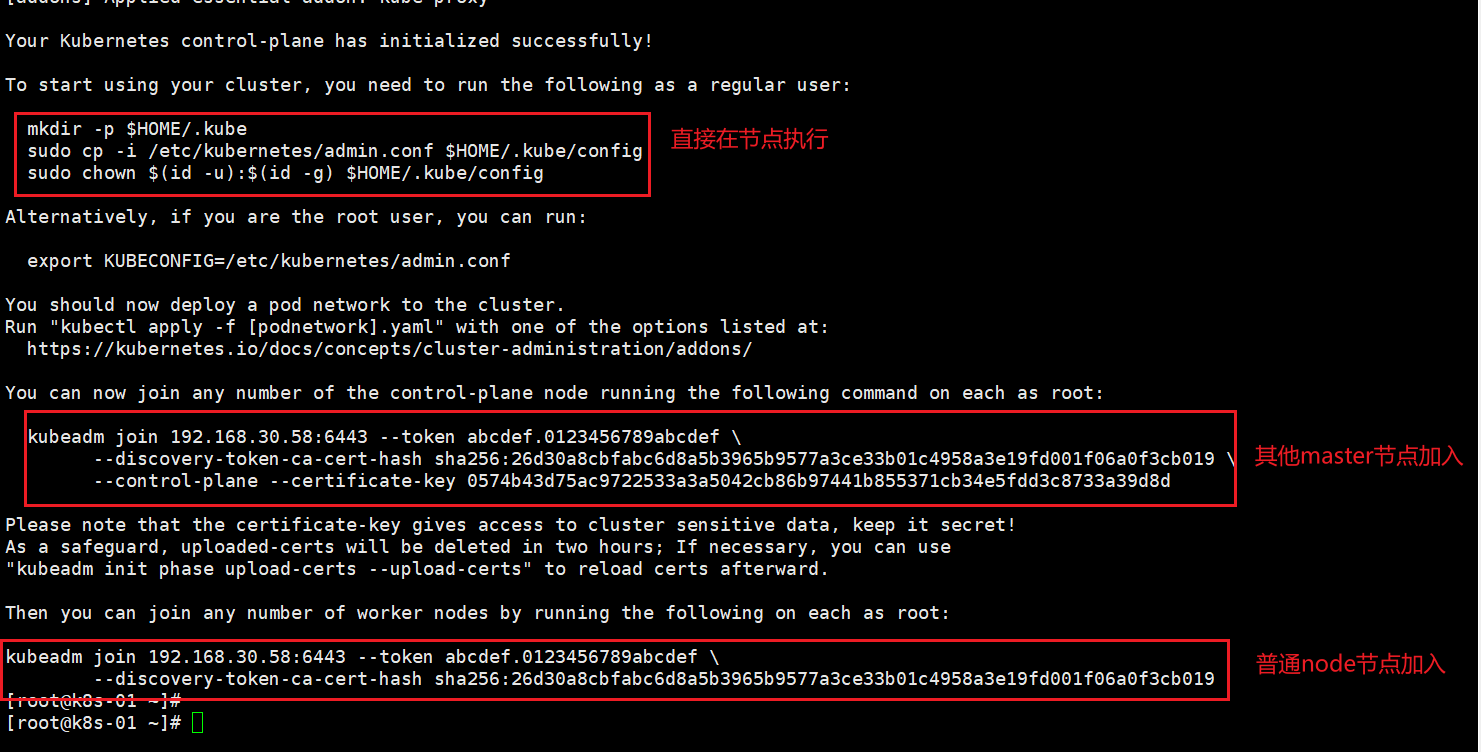一、固定IP地址
#配置
sudo nmcli connection modify ens160 \
ipv4.method manual \
ipv4.addresses 192.168.30.50/24 \
ipv4.gateway 192.168.30.2 \
ipv4.dns "8.8.8.8,8.8.4.4"
#更新配置
sudo nmcli connection down ens160 && sudo nmcli connection up ens160二、准备工作
2.0 修改主机名
#每个节点对应一个
hostnamectl set-hostname k8s-01
hostnamectl set-hostname k8s-02
hostnamectl set-hostname k8s-03#提前配好vip ip 三个节点都要做
cat >>/etc/hosts <<'EOF'
192.168.30.50 k8s-01
192.168.30.51 k8s-02
192.168.30.52 k8s-03
192.168.30.58 k8s-vip
EOF2.1 配置yum源
#sudo mkdir /etc/yum.repos.d/backup
#sudo mv /etc/yum.repos.d/*.repo /etc/yum.repos.d/backup/
直接执行下面的
# 使用阿里云推荐的配置方法
sudo sed -e 's!^mirrorlist=!#mirrorlist=!g' \
-e 's!^#baseurl=http://dl.rockylinux.org/$contentdir!baseurl=https://mirrors.aliyun.com/rockylinux!g' \
-i /etc/yum.repos.d/Rocky-*.repo
#清理并重建缓存
sudo dnf clean all
sudo dnf makecache
#测试更新
sudo dnf -y update
sudo dnf -y install wget curl vim tar gzip2.2设置时区
#查看当前时区设置
timedatectl
#设置时区为中国时区(上海时间)
sudo timedatectl set-timezone Asia/Shanghai2.3设置时间
#安装并配置 Chrony(推荐)
# RHEL/CentOS/Alma/Rocky
sudo dnf -y install chrony || sudo yum -y install chrony
sudo systemctl enable --now chronyd
# 编辑配置文件
sudo vi /etc/chrony.conf
#把默认的 pool/server 行注释掉(没外网也无用),然后加入(或确认存在)以下内容:
# 把 30.50 作为“本地时间源”,无外部上游时自成一体
local stratum 10
# 允许本网段客户端访问
allow 192.168.30.0/24
# 绑定监听到这块网卡(可选,但建议写上)
bindaddress 192.168.30.50
# 客户端第一次偏差大时允许快速步进校时
makestep 1 3
# 用系统时钟做源,且把系统时间同步到硬件时钟(断电后也较准)
rtcsync
#保存重启
sudo systemctl restart chronyd
#防火墙放行
# firewalld(RHEL系)
sudo firewall-cmd --add-service=ntp --permanent
sudo firewall-cmd --reload
#验证服务器状态
# 查看 chrony 源与自我状态
chronyc tracking
# 查看已连接的客户端(执行一会儿后能看到)
chronyc clients
# 确认监听 123/udp
sudo ss -lunp | grep :123# 客户端安装
# RHEL系
sudo dnf -y install chrony || sudo yum -y install chrony
# Debian/Ubuntu
sudo apt -y install chrony
# 配置(RHEL: /etc/chrony.conf;Ubuntu/Debian: /etc/chrony/chrony.conf)
# 注释掉原来的 pool/server 行,新增:
server 192.168.30.50 iburst
# 重启并查看
sudo systemctl restart chronyd
chronyc sources -v
chronyc tracking2.4关闭swap分区
sudo swapoff -a
sudo sed -ri '/\sswap\s/s/^#?/#/' /etc/fstab2.5关闭selinux
sudo systemctl disable --now firewalld
#推荐:保持 Enforcing(Kubernetes + containerd 在 RHEL9 系已支持),同时安装策略包:
sudo dnf -y install container-selinux
getenforce # 看到 Enforcing 即可
#图省事(不太安全):设为 Permissive:
sudo setenforce 0
sudo sed -i 's/^SELINUX=enforcing/SELINUX=permissive/' /etc/selinux/config2.6内核模块与 sysctl(所有节点)
# 加载并持久化必须内核模块
cat <<'EOF' | sudo tee /etc/modules-load.d/k8s.conf
overlay
br_netfilter
EOF
sudo modprobe overlay
sudo modprobe br_netfilter
# 必备内核参数(转发与桥接)
cat <<'EOF' | sudo tee /etc/sysctl.d/99-kubernetes-cri.conf
net.bridge.bridge-nf-call-iptables = 1
net.bridge.bridge-nf-call-ip6tables = 1
net.ipv4.ip_forward = 1
EOF
sudo sysctl --system
#说明:RHEL9/ Rocky9 默认 cgroup v2,Kubernetes + containerd 完全支持,无需改动。2.7文件描述符(fd/ulimit)与进程数
# 系统级最大打开文件数
cat > /etc/security/limits.d/k8s.conf <<EOF
* soft nofile 65535
* hard nofile 131070
EOF
ulimit -Sn
ulimit -Hn2.8kube-proxy 的 IPVS 模式
#安装
sudo dnf -y install ipset ipvsadm
cat <<'EOF' | sudo tee /etc/modules-load.d/k8s.conf
overlay
br_netfilter
# 如启用 IPVS,取消以下行的注释:
ip_vs
ip_vs_rr
ip_vs_wrr
ip_vs_sh
nf_conntrack
EOF
# 立即加载
sudo modprobe overlay
sudo modprobe br_netfilter
# 如果要用 IPVS,再执行:
for m in ip_vs ip_vs_rr ip_vs_wrr ip_vs_sh nf_conntrack; do sudo modprobe $m; done
#验证模块
lsmod | egrep 'br_netfilter|ip_vs|nf_conntrack'三、安装containerd(所有k8s节点都要做)
3.1 使用阿里云的源
sudo dnf config-manager --set-enabled powertools # Rocky Linux 8/9需启用PowerTools仓库
sudo dnf install -y yum-utils device-mapper-persistent-data lvm2
#1、卸载之前的
dnf remove docker docker-ce containerd docker-common docker-selinux docker-engine -y
#2、准备repo
sudo tee /etc/yum.repos.d/docker-ce.repo <<-'EOF'
[docker-ce-stable]
name=Docker CE Stable - AliOS
baseurl=https://mirrors.aliyun.com/docker-ce/linux/centos/$releasever/$basearch/stable
enabled=1
gpgcheck=1
gpgkey=https://mirrors.aliyun.com/docker-ce/linux/centos/gpg
EOF
# 3、安装
sudo dnf install -y containerd.io
sudo dnf install containerd* -y3.2配置
# 1、配置
mkdir -pv /etc/containerd
containerd config default > /etc/containerd/config.toml #为containerd生成配置文件
#2、替换默认pause镜像地址:这一步非常非常非常非常重要
grep sandbox_image /etc/containerd/config.toml
sudo sed -i 's|registry.k8s.io/pause:3.8|registry.cn-guangzhou.aliyuncs.com/xingcangku/registry.k8s.io-pause:3.8|g' /etc/containerd/config.toml
grep sandbox_image /etc/containerd/config.toml
#请务必确认新地址是可用的:
sandbox_image = "registry.cn-guangzhou.aliyuncs.com/xingcangku/registry.k8s.io-pause:3.8"
#3、配置systemd作为容器的cgroup driver
grep SystemdCgroup /etc/containerd/config.toml
sed -i 's/SystemdCgroup \= false/SystemdCgroup \= true/' /etc/containerd/config.toml
grep SystemdCgroup /etc/containerd/config.toml
# 4、配置加速器(必须配置,否则后续安装cni网络插件时无法从docker.io里下载镜像)
#参考:https://github.com/containerd/containerd/blob/main/docs/cri/config.md#registry-configuration
#添加 config_path="/etc/containerd/certs.d"
sed -i 's/config_path\ =.*/config_path = \"\/etc\/containerd\/certs.d\"/g' /etc/containerd/config.tomlmkdir -p /etc/containerd/certs.d/docker.io
cat>/etc/containerd/certs.d/docker.io/hosts.toml << EOF
server ="https://docker.io"
[host."https ://dockerproxy.com"]
capabilities = ["pull","resolve"]
[host."https://docker.m.daocloud.io"]
capabilities = ["pull","resolve"]
[host."https://docker.chenby.cn"]
capabilities = ["pull","resolve"]
[host."https://registry.docker-cn.com"]
capabilities = ["pull","resolve" ]
[host."http://hub-mirror.c.163.com"]
capabilities = ["pull","resolve" ]
EOF#5、配置containerd开机自启动
#5.1 启动containerd服务并配置开机自启动
systemctl daemon-reload && systemctl restart containerd
systemctl enable --now containerd
#5.2 查看containerd状态
systemctl status containerd
#5.3查看containerd的版本
ctr version四、安装nginx+keepalived
#安装与开启
dnf install -y nginx keepalived curl
dnf install -y nginx-mod-stream
systemctl enable nginx keepalived
#配置 Nginx(两台 Master 都要配)
#目标:在本机 0.0.0.0:16443 监听,转发到两个后端的 kube-apiserver(50:16443、51:16443)
#编辑 /etc/nginx/nginx.conf(保留 http 段也没关系,关键是顶层加上 stream 段;Rocky9 的 nginx 支持动态模块):
# /etc/nginx/nginx.conf
user nginx;
worker_processes auto;
error_log /var/log/nginx/error.log;
pid /run/nginx.pid;
# 使用系统提供的动态模块配置(若已安装将自动加载 stream 模块)
include /usr/share/nginx/modules/*.conf;
events { worker_connections 10240; }
# 四层转发到两台 apiserver
stream {
upstream k8s_apiserver {
server 192.168.30.50:6443 max_fails=3 fail_timeout=10s;
server 192.168.30.51:6443 max_fails=3 fail_timeout=10s;
}
server {
listen 0.0.0.0:16443;
proxy_connect_timeout 5s;
proxy_timeout 30s;
proxy_pass k8s_apiserver;
}
}
http {
# 这里保持nginx默认 http 配置即可,删与不删均可。
include /etc/nginx/mime.types;
default_type application/octet-stream;
sendfile on;
keepalive_timeout 65;
server { listen 81; return 200 "ok\n"; }
}
#配置 Keepalived(两台 Master)
#创建健康检查脚本 /etc/keepalived/check_nginx_kube.sh:
cat >/etc/keepalived/check_nginx_kube.sh <<'EOF'
#!/usr/bin/env bash
# 通过本地Nginx转发口探活K8s apiserver(无认证的 /readyz,HTTP 200 即通过)
curl -fsSk --connect-timeout 2 https://127.0.0.1:16443/readyz >/dev/null
EOF
chmod +x /etc/keepalived/check_nginx_kube.sh
#Master1(192.168.30.50) 的 /etc/keepalived/keepalived.conf:
! Configuration File for keepalived
global_defs {
router_id LVS_K8S_50
# vrrp_strict # 若使用部分虚拟化/容器网络会引发问题,可注释掉
}
vrrp_script chk_nginx_kube {
script "/etc/keepalived/check_nginx_kube.sh"
interval 3
timeout 2
fall 2
rise 2
weight -20
}
vrrp_instance VI_1 {
state BACKUP
interface ens160 # 改为你的网卡
virtual_router_id 58 # 1-255 任意一致值,这里取 58
priority 150 # Master1 高优先
advert_int 1
# 单播,避免二层组播受限环境(强烈推荐)
unicast_src_ip 192.168.30.50
unicast_peer {
192.168.30.51
}
authentication {
auth_type PASS
auth_pass 9c9c58
}
virtual_ipaddress {
192.168.30.58/24 dev ens160
}
track_script {
chk_nginx_kube
}
}
#Master2(192.168.30.151) 的 /etc/keepalived/keepalived.conf:
! Configuration File for keepalived
global_defs {
router_id LVS_K8S_51
# vrrp_strict
}
vrrp_script chk_nginx_kube {
script "/etc/keepalived/check_nginx_kube.sh"
interval 3
timeout 2
fall 2
rise 2
weight -20
}
vrrp_instance VI_1 {
state BACKUP
interface ens160
virtual_router_id 58
priority 100 # 次优先
advert_int 1
unicast_src_ip 192.168.30.51
unicast_peer {
192.168.30.50
}
authentication {
auth_type PASS
auth_pass 9c9c58
}
virtual_ipaddress {
192.168.30.58/24 dev ens160
}
track_script {
chk_nginx_kube
}
}
#启动
systemctl restart keepalived
ip a | grep 192.168.30.58
#停掉 Master1 的 keepalived:systemctl stop keepalived,VIP 应在 Master2 出现,验证完再 systemctl start keepalived。五、安装k8s
5.1 准备k8s源
# 创建repo文件
cat <<EOF | sudo tee /etc/yum.repos.d/kubernetes.repo
[kubernetes]
name=Kubernetes
baseurl=https://mirrors.aliyun.com/kubernetes/yum/repos/kubernetes-el7-x86_64/
enabled=1
gpgcheck=1
repo_gpgcheck=1
gpgkey=https://mirrors.aliyun.com/kubernetes/yum/doc/yum-key.gpg https://mirrors.aliyun.com/kubernetes/yum/doc/rpm-package-key.gpg
EOF
sudo dnf makecache
#参考:https://developer.aliyun.com/mirror/kubernetes/setenforce
dnf install -y kubelet-1.27* kubeadm-1.27* kubectl-1.27*
systemctl enable kubelet && systemctl start kubelet && systemctl status kubelet
安装锁定版本的插件
sudo dnf install -y dnf-plugin-versionlock
锁定版本不让后续更新sudo dnf versionlock add kubelet-1.27* kubeadm-1.27* kubectl-1.27* containerd.io
[root@k8s-01 ~]# sudo dnf versionlock list
Last metadata expiration check: 0:35:21 ago on Fri Aug 8 10:40:25 2025.
kubelet-0:1.27.6-0.*
kubeadm-0:1.27.6-0.*
kubectl-0:1.27.6-0.*
containerd.io-0:1.7.27-3.1.el9.*
#sudo dnf update就会排除锁定的应用5.2 主节点操作(node节点不执行)
[root@k8s-01 ~]# kubeadm config images list
I0906 16:16:30.198629 49023 version.go:256] remote version is much newer: v1.34.0; falling back to: stable-1.27
registry.k8s.io/kube-apiserver:v1.27.16
registry.k8s.io/kube-controller-manager:v1.27.16
registry.k8s.io/kube-scheduler:v1.27.16
registry.k8s.io/kube-proxy:v1.27.16
registry.k8s.io/pause:3.9
registry.k8s.io/etcd:3.5.7-0
registry.k8s.io/coredns/coredns:v1.10.1
kubeadm config print init-defaults > kubeadm.yaml[root@k8s-01 ~]# cat kubeadm.yaml
# kubeadm-config.yaml
apiVersion: kubeadm.k8s.io/v1beta3
kind: InitConfiguration
bootstrapTokens:
- token: abcdef.0123456789abcdef
ttl: 24h0m0s
usages: ["signing","authentication"]
groups: ["system:bootstrappers:kubeadm:default-node-token"]
localAPIEndpoint:
# 这里必须是你要执行 kubeadm init 的这台机器的真实IP(Master1)
advertiseAddress: 192.168.30.50
bindPort: 6443
nodeRegistration:
criSocket: unix:///run/containerd/containerd.sock
imagePullPolicy: IfNotPresent
# 不要在这里硬编码 name,默认会用主机的 hostname,避免复用此文件时出错
taints: null
---
apiVersion: kubeadm.k8s.io/v1beta3
kind: ClusterConfiguration
clusterName: kubernetes
kubernetesVersion: v1.27.16
controlPlaneEndpoint: "192.168.30.58:16443" # 指向 Nginx+Keepalived 的 VIP:PORT
certificatesDir: /etc/kubernetes/pki
imageRepository: registry.cn-hangzhou.aliyuncs.com/google_containers
networking:
dnsDomain: cluster.local
serviceSubnet: 10.96.0.0/12
podSubnet: 10.244.0.0/16 # 供 Calico 使用,此网段可保持不变
apiServer:
timeoutForControlPlane: 4m0s
certSANs:
# 建议把 VIP、两台 Master 的 IP 和主机名都放进 SAN,避免证书不信任
- "192.168.30.58" # VIP
- "192.168.30.50"
- "192.168.30.51"
- "k8s-01" # 如你的主机名不同,请改成实际 hostname
- "k8s-02"
- "127.0.0.1"
- "localhost"
- "kubernetes"
- "kubernetes.default"
- "kubernetes.default.svc"
- "kubernetes.default.svc.cluster.local"
controllerManager: {}
scheduler: {}
etcd:
local:
dataDir: /var/lib/etcd
---
apiVersion: kubeproxy.config.k8s.io/v1alpha1
kind: KubeProxyConfiguration
mode: "ipvs"
---
apiVersion: kubelet.config.k8s.io/v1beta1
kind: KubeletConfiguration
cgroupDriver: "systemd"root@k8s-01 ~]# kubeadm init --config kubeadm.yaml --upload-certs
[init] Using Kubernetes version: v1.27.16
[preflight] Running pre-flight checks
[preflight] Pulling images required for setting up a Kubernetes cluster
[preflight] This might take a minute or two, depending on the speed of your internet connection
[preflight] You can also perform this action in beforehand using 'kubeadm config images pull'
W0906 17:26:53.821977 54526 checks.go:835] detected that the sandbox image "registry.cn-guangzhou.aliyuncs.com/xingcangku/registry.k8s.io-pause:3.8" of the container runtime is inconsistent with that used by kubeadm. It is recommended that using "registry.cn-hangzhou.aliyuncs.com/google_containers/pause:3.9" as the CRI sandbox image.
[certs] Using certificateDir folder "/etc/kubernetes/pki"
[certs] Generating "ca" certificate and key
[certs] Generating "apiserver" certificate and key
[certs] apiserver serving cert is signed for DNS names [k8s-01 k8s-02 kubernetes kubernetes.default kubernetes.default.svc kubernetes.default.svc.cluster.local localhost] and IPs [10.96.0.1 192.168.30.50 192.168.30.58 192.168.30.51 127.0.0.1]
[certs] Generating "apiserver-kubelet-client" certificate and key
[certs] Generating "front-proxy-ca" certificate and key
[certs] Generating "front-proxy-client" certificate and key
[certs] Generating "etcd/ca" certificate and key
[certs] Generating "etcd/server" certificate and key
[certs] etcd/server serving cert is signed for DNS names [k8s-01 localhost] and IPs [192.168.30.50 127.0.0.1 ::1]
[certs] Generating "etcd/peer" certificate and key
[certs] etcd/peer serving cert is signed for DNS names [k8s-01 localhost] and IPs [192.168.30.50 127.0.0.1 ::1]
[certs] Generating "etcd/healthcheck-client" certificate and key
[certs] Generating "apiserver-etcd-client" certificate and key
[certs] Generating "sa" key and public key
[kubeconfig] Using kubeconfig folder "/etc/kubernetes"
[kubeconfig] Writing "admin.conf" kubeconfig file
[kubeconfig] Writing "kubelet.conf" kubeconfig file
[kubeconfig] Writing "controller-manager.conf" kubeconfig file
[kubeconfig] Writing "scheduler.conf" kubeconfig file
[kubelet-start] Writing kubelet environment file with flags to file "/var/lib/kubelet/kubeadm-flags.env"
[kubelet-start] Writing kubelet configuration to file "/var/lib/kubelet/config.yaml"
[kubelet-start] Starting the kubelet
[control-plane] Using manifest folder "/etc/kubernetes/manifests"
[control-plane] Creating static Pod manifest for "kube-apiserver"
[control-plane] Creating static Pod manifest for "kube-controller-manager"
[control-plane] Creating static Pod manifest for "kube-scheduler"
[etcd] Creating static Pod manifest for local etcd in "/etc/kubernetes/manifests"
[wait-control-plane] Waiting for the kubelet to boot up the control plane as static Pods from directory "/etc/kubernetes/manifests". This can take up to 4m0s
[apiclient] All control plane components are healthy after 12.002658 seconds
[upload-config] Storing the configuration used in ConfigMap "kubeadm-config" in the "kube-system" Namespace
[kubelet] Creating a ConfigMap "kubelet-config" in namespace kube-system with the configuration for the kubelets in the cluster
[upload-certs] Storing the certificates in Secret "kubeadm-certs" in the "kube-system" Namespace
[upload-certs] Using certificate key:
0574b43d75ac9722533a3a5042cb86b97441b855371cb34e5fdd3c8733a39d8d
[mark-control-plane] Marking the node k8s-01 as control-plane by adding the labels: [node-role.kubernetes.io/control-plane node.kubernetes.io/exclude-from-external-load-balancers]
[mark-control-plane] Marking the node k8s-01 as control-plane by adding the taints [node-role.kubernetes.io/control-plane:NoSchedule]
[bootstrap-token] Using token: abcdef.0123456789abcdef
[bootstrap-token] Configuring bootstrap tokens, cluster-info ConfigMap, RBAC Roles
[bootstrap-token] Configured RBAC rules to allow Node Bootstrap tokens to get nodes
[bootstrap-token] Configured RBAC rules to allow Node Bootstrap tokens to post CSRs in order for nodes to get long term certificate credentials
[bootstrap-token] Configured RBAC rules to allow the csrapprover controller automatically approve CSRs from a Node Bootstrap Token
[bootstrap-token] Configured RBAC rules to allow certificate rotation for all node client certificates in the cluster
[bootstrap-token] Creating the "cluster-info" ConfigMap in the "kube-public" namespace
[kubelet-finalize] Updating "/etc/kubernetes/kubelet.conf" to point to a rotatable kubelet client certificate and key
[addons] Applied essential addon: CoreDNS
[addons] Applied essential addon: kube-proxy
Your Kubernetes control-plane has initialized successfully!
To start using your cluster, you need to run the following as a regular user:
mkdir -p $HOME/.kube
sudo cp -i /etc/kubernetes/admin.conf $HOME/.kube/config
sudo chown $(id -u):$(id -g) $HOME/.kube/config
Alternatively, if you are the root user, you can run:
export KUBECONFIG=/etc/kubernetes/admin.conf
You should now deploy a pod network to the cluster.
Run "kubectl apply -f [podnetwork].yaml" with one of the options listed at:
https://kubernetes.io/docs/concepts/cluster-administration/addons/
You can now join any number of the control-plane node running the following command on each as root:
kubeadm join 192.168.30.58:6443 --token abcdef.0123456789abcdef \
--discovery-token-ca-cert-hash sha256:26d30a8cbfabc6d8a5b3965b9577a3ce33b01c4958a3e19fd001f06a0f3cb019 \
--control-plane --certificate-key 0574b43d75ac9722533a3a5042cb86b97441b855371cb34e5fdd3c8733a39d8d
Please note that the certificate-key gives access to cluster sensitive data, keep it secret!
As a safeguard, uploaded-certs will be deleted in two hours; If necessary, you can use
"kubeadm init phase upload-certs --upload-certs" to reload certs afterward.
Then you can join any number of worker nodes by running the following on each as root:
kubeadm join 192.168.30.58:6443 --token abcdef.0123456789abcdef \
--discovery-token-ca-cert-hash sha256:26d30a8cbfabc6d8a5b3965b9577a3ce33b01c4958a3e19fd001f06a0f3cb019 #如果出现失败的情况
kubeadm reset -f
[root@k8s-01 ~]# kubeadm reset -f
[preflight] Running pre-flight checks
W0906 17:08:03.892290 53705 removeetcdmember.go:106] [reset] No kubeadm config, using etcd pod spec to get data directory
[reset] Deleted contents of the etcd data directory: /var/lib/etcd
[reset] Stopping the kubelet service
[reset] Unmounting mounted directories in "/var/lib/kubelet"
W0906 17:08:03.899240 53705 cleanupnode.go:134] [reset] Failed to evaluate the "/var/lib/kubelet" directory. Skipping its unmount and cleanup: lstat /var/lib/kubelet: no such file or directory
[reset] Deleting contents of directories: [/etc/kubernetes/manifests /etc/kubernetes/pki]
[reset] Deleting files: [/etc/kubernetes/admin.conf /etc/kubernetes/kubelet.conf /etc/kubernetes/bootstrap-kubelet.conf /etc/kubernetes/controller-manager.conf /etc/kubernetes/scheduler.conf]
The reset process does not clean CNI configuration. To do so, you must remove /etc/cni/net.d
The reset process does not reset or clean up iptables rules or IPVS tables.
If you wish to reset iptables, you must do so manually by using the "iptables" command.
If your cluster was setup to utilize IPVS, run ipvsadm --clear (or similar)
to reset your systems IPVS tables.
The reset process does not clean your kubeconfig files and you must remove them manually.
Please, check the contents of the $HOME/.kube/config file.
#还需要手动删除
rm -rf /$HOME/.kube/config
systemctl restart containerd
rm -rf ~/.kube /etc/kubernetes/pki/* /etc/kubernetes/manifests/*
#安装 CNI
#Flannel(简单)
kubectl apply -f https://raw.githubusercontent.com/flannel-io/flannel/v0.25.5/Documentation/kube-flannel.yml
#Calico(功能更全)
kubectl apply -f https://raw.githubusercontent.com/projectcalico/calico/v3.27.3/manifests/calico.yaml
[root@k8s-02 ~]# kubectl get pod -A
NAMESPACE NAME READY STATUS RESTARTS AGE
kube-system calico-kube-controllers-59765c79db-rvqm5 1/1 Running 0 8m3s
kube-system calico-node-4jlgw 1/1 Running 0 8m3s
kube-system calico-node-lvzgx 1/1 Running 0 8m3s
kube-system calico-node-qdrmn 1/1 Running 0 8m3s
kube-system coredns-65dcc469f7-gktmx 1/1 Running 0 51m
kube-system coredns-65dcc469f7-wmppd 1/1 Running 0 51m
kube-system etcd-k8s-01 1/1 Running 0 51m
kube-system etcd-k8s-02 1/1 Running 0 20m
kube-system kube-apiserver-k8s-01 1/1 Running 0 51m
kube-system kube-apiserver-k8s-02 1/1 Running 0 19m
kube-system kube-controller-manager-k8s-01 1/1 Running 1 (20m ago) 51m
kube-system kube-controller-manager-k8s-02 1/1 Running 0 19m
kube-system kube-proxy-k7z9v 1/1 Running 0 22m
kube-system kube-proxy-sgrln 1/1 Running 0 51m
kube-system kube-proxy-wpkjb 1/1 Running 0 20m
kube-system kube-scheduler-k8s-01 1/1 Running 1 (19m ago) 51m
kube-system kube-scheduler-k8s-02 1/1 Running 0 19m
#测试切换
#在当前 VIP 所在主机执行:
systemctl stop keepalived
#观察另外一台是否接管 VIP:
ip a | grep 192.168.30.58
#再次访问: 正常会返回ok
curl -k https://192.168.30.58:6443/readyz
#恢复 vip会自动漂移回来
systemctl start keepalived#kubectl 正常
[root@k8s-01 ~]# kubectl get cs 2>/dev/null || \
kubectl get --raw='/readyz?verbose' | head
NAME STATUS MESSAGE ERROR
scheduler Healthy ok
controller-manager Healthy ok
etcd-0 Healthy 

评论 (0)